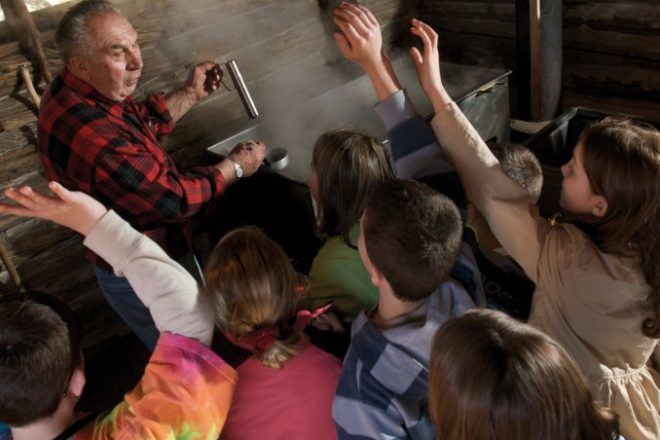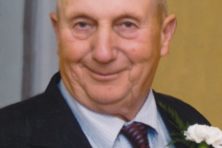The Legacy of Carl Scholz
- Share
- Tweet
- Pin
- Share

Hiring teachers is a routine responsibility for boards of education, but the Sevastopol school board members who employed Carl Scholz as a first-year agriculture teacher in 1951 couldn’t possibly have known that they’d hired a man who would create so many positive changes, in so many aspects of school and community life, for so many years.
“He was a multipurpose educator who led us on a positive journey, serving as a teacher, principal, superintendent, transportation director, school-bus driver, conservation cultivator, organizer of the Sevastopol Arbor Day Program, guest speaker (sometimes with live animals), maple-syrup boiler, mentor and champion of education and the community,” said Mike Madden, one of Scholz’s former students, who also later taught at Sevastopol High School.
Madden spoke Aug. 27 during the dedication of the new Carl Scholz Pioneer Room at Sevastopol.
“This will always remind us of the positive influence Mr. Scholz has provided for 70 years – almost three-fourths of the school’s history,” Madden said. “Carl and Ruth Scholz are examples of what makes our school district shine in the eyes of those who have been part of the Sevastopol experience.”
Since February 2021, Scholz has been receiving rehab services at Anna’s Healthcare in Sturgeon Bay, with his wife, Ruth, by his side daily. In recalling his life, which began in 1927 on a farm in Waubeka, Wisconsin, Scholz said the most important things he learned from his parents were to work hard, be a gentleman and get along with people.
As a fifth-grader, he wrote an essay saying that his goal was to manage a wildlife refuge when he grew up. He enlisted as a paratrooper as soon as he’d graduated from Port Washington High School at age 17, and when World War II was over, he used the GI Bill to earn a degree in agricultural education at UW-Madison.
He was 23 when he arrived in Door County as a fresh-faced teacher, and, before school had even started, he visited the 4-H Camp at Horseshoe Bay, ate several butterhorn rolls and was introduced to Ruth Knowles, the county Extension agent, who claimed to have baked the rolls. He wooed her with tickets to Peninsula Players Theatre and a corsage he’d fashioned from carrots and celery, and she surmised – correctly – that she’d have an interesting life with a man who had such a sense of humor. They were married the following May and eventually had four children: Marsha, Jane, Jon and Carla.
Within three years, Scholz was named Sevastopol’s supervising principal, a title that soon evolved into superintendent. He was the youngest superintendent in the state at that time and held the position for 34 years – the longest tenure ever in Wisconsin.
Nature was dear to Scholz’s heart, and one of the first groups he organized at Sevastopol was the Conservation Club. Madden recalled being a student at Jacksonport’s two-room school when he first met the superintendent.
“This man in a suit showed up in a bus and took all of us, grades 1-8, to plant trees behind the town hall,” he said.
Members of the Conservation Club built the carp barricade at the dam on Kangaroo Lake, cooperated with many projects at The Ridges Sanctuary, and developed the Sevastopol Nature Trail and the Ecology Lab on 80 acres of school property, purchased with $5,000 of “bounty money” that Scholz had obtained from the Wisconsin Department of Natural Resources. Two current Sevastopol teachers, Brooke Tanck and Katie Grooters, and their students are restoring the area.
Although the camping trips Scholz took Conservation Club members on for 35 years were primarily billed as fishing expeditions, he never missed an opportunity to teach while providing new experiences. For example, the Door County Advocate reported that the five-day trip in June 1956 included stops at not only a trout farm, but also a cranberry bog, fur farm, lumber mill on an Indian reservation, Rib Mountain, Plymouth, Three Lakes, Poynette, Wisconsin Rapids and the Kettle Moraine area. On another trip to the Limnology Project near Boulder Junction, the group of 15 or 20 was required to keep the 800 fish they’d caught.
Madden recalled that the superintendent expected respect by and for everyone in the school and stressed that no person or job was more important than any other.
“He modeled this by grabbing a mop if a toilet overflowed,” Madden said, “and I never saw him not stop to pick up a piece of litter when he walked the hallways.”
As part of a group of high school boys who often needed reminders about behavior, Madden also remembered that everyone knew Scholz meant what he said, and he always followed discipline with positive encouragement or, if necessary, consequences. When Madden, at 16, felt the need to rebel against the dress code and went to school without wearing a belt, “Mr. Scholz offered me his own belt, or a piece of twine to hold up my pants, or a ride home to get a belt. I wore a belt the following day.”

Scholz was a man ahead of his time. When other schools were stocking vending machines with soda and candy, Sevastopol provided milk and apples. He also offered apples to colleagues who wanted to smoke during meetings – part of his lifelong campaign against tobacco use. In 1972, Scholz received an award from the American Cancer Society for running one of the few schools in the country to be tobacco free since 1955.
Scholz believed that the school lunch hour was the most important class period of the day because “the finest teacher can’t motivate a hungry child.” And he is especially proud that the consolidation of eight one-room elementary schools into the Sevastopol District went smoothly, with those students immediately receiving free bus service and hot lunches delivered to their locations until they were all incorporated into the Sevastopol campus.
In 1971, the Door County Board asked Scholz to oversee special education in all of Door County – a job he did for more than three years. During that time, Sevastopol became the first school to provide special-education services in its own building. The countywide committee he worked with eventually led to the creation of Sunshine House, which continues to provide services to people with special needs.
Sevastopol was also the first district in Door County to provide day care for about 180 children of migrant families. Buses picked up the youngsters from the migrant camps and orchards for summer programs, and they were welcomed into regular school classes if their parents remained in the county during the fall.
In addition to his conservation work with students, Scholz was deeply involved in similar activities within the community. He formed the Door County Natural Beauty Council, inspired by Lady Bird Johnson, and led annual bus tours to acquaint residents with the beauty of the area. He was also a member of the Door County Conservation Committee and the Lake Michigan Federation. When the Coast Guard announced plans to use eight locations for light machine-gun training with live ammo going into the lake, his was the lone voice that shut the project down.
In 1967, Scholz initiated Land Appreciation Day with 240 students from Sevastopol and Southern Door. In 1970, he proposed removing all billboards from Door County within three years – one of very few of his ideas that didn’t come to fruition. He was also part of the group that objected to taking acres of productive farmland to build the new bridge in Sturgeon Bay, but when the site was confirmed, he volunteered to help with landscaping.
Scholz was a strong supporter of fair state funding for education, accusing some Wisconsin legislators in a July 1967 Door County Advocate story of having “a troubled conscience in regard to their support and proper financing of education,” as evidenced by those legislators’ attempt to “rationalize dereliction of responsibility to Wisconsin schools and the state’s citizens.”
Despite Scholz’s ongoing fight for equitable state aid, in 1971, Gov. Patrick Lucey, whose stand on school funding would have hurt Sevastopol, presented Scholz with the first award of his administration for the beautification of Door County. Ruth and other members of their family were in the audience, as were Emma Toft and Roy Lukes. Scholz considered Toft and Lukes close friends and mentors – stacks of hand-written letters attest to this – along with Aldo Leopold, whom Scholz met as a teenager at two state conservation camps.
In 2010, the Lakeshore Natural Resources Partnership honored Scholz with its Champion of Champions Award for Water Resource Protection. Earlier, he had also received honors from the Door County Land Trust and the Wisconsin FFA.
Scholz has been a longtime supporter of The Nature Conservancy and The Clearing and was a member of Rotary, the Door County Mental Health Commission, Door County Library Board, Door County Fair Board, Wisconsin Council on Youth Participation, White House Conference on Children and Youth, and Audubon Society. He was president of Bay View Lutheran Church, the Door County Teachers Association, The Ridges’ board of directors and the Wigwam Nursery Board.

He was also instrumental in starting the Peninsula Athletic Conference and was invited by Gov. Warren Knowles – a strong proponent of conservation – to serve on the Citizens Advisory Council, which developed the academic plan for the UW-Green Bay College of Environmental Services.
Scholz’s participation in so many facets of life across the decades is well documented in 638 stories at doorcountynewspapers.org, the Door County Library’s online newspaper archive site. Ruth was always part of the team, whether that meant typing papers for his graduate classes or raising their four children when he was committed elsewhere.
“It wasn’t always easy,” she said.
Those busy days produced stories that Carl and Ruth find humorous to recall, however. Like the time Scholz stayed longer than he’d planned at a student activity and suddenly realized he was due at a party and was supposed to pick up a cake on the way. Surprised with shouts of “Happy anniversary!” when he arrived at the party, he asked whose anniversary it was. It was his and Ruth’s fifth.
There was also the time when Ruth went along when Carl drove the bus for the wrestling team to a meet in Coleman. The bus had traveled a few miles toward home when one of the wrestlers pointed out that Ruth was not aboard.
“I’ve never let him forget that,” she said with a laugh.
Scholz, obviously, has always been a person who got things done. When the school and nearby community experienced sewage problems during the early 1970s, he obtained $500,000 from the Federal Clean Water Act to construct the Sevastopol Sanitary District, which included the Institute and Valmy areas.
Appointed by Gov. Gaylord Nelson to the Wisconsin Natural Resource Commission, Scholz is still very proud of being one of the plaintiffs in a lawsuit filed against 15 paper mills under the Clean Water Act that led to cleaning up the Fox River. (As a child, the condition of that river always worried him.) Against all odds, they won the lawsuit before Scholz retired in 1989, but the final dredging was done just this summer.
Scholz has also been known as a man who could calm crowds and solve delicate problems. Curley Paul’s 19th Hole column in the Door County Advocate on Feb. 26, 1976, noted that “Carl Scholz did an excellent job in handling the crowd” during a tense basketball game when the Sevastopol Pioneers defeated Manitowoc Lutheran 77-76.
When Sevastopol was sued by an attorney for the Department of Public Instruction because it was using district-owned buses to transport both parochial- and public-school students, Scholz quickly assembled a group of friends to buy the buses, and worked to get the state law changed, then sold the buses back to the district to continue its previous practice of getting all students where they needed to go.
In his spare time, Scholz carved walking sticks and taught at least 300 others how to make them through classes at The Clearing.
At 94 years old, Scholz has slowed down, but he’s hardly idle at Anna’s Healthcare. A participant in the Door County Bird Count for more than 50 years and still an avid bird watcher, he’s teaching other residents about fisher crows, the endangered species he’d spotted out his south window.
And what of those trees that Jacksonport School students planted behind the town hall when Mike Madden was a boy? They’re still growing. The Sevastopol Arbor Day Program that Scholz initiated decades ago is still going, too. For a week in mid-September, the school’s fourth-graders were at Culver’s during the dinner rush to help in the dining room and drive-through to raise funds for their trip to Trees for Tomorrow. Carl Scholz’s positive influence lives on!
The Farm Is Born
During a family trip in 1964, curiosity caused Orville Schopf to stop in Waukesha at a place called Old McDonald’s Farm. He thought that a similar place where children and baby animals could run free together, and where youngsters could get an idea of what farm life was like, would be a wonderful attraction for Door County.
By the next summer, Carl Scholz, George Evenson, Ralph Roth and their wives had joined Orville and Sal Schopf in purchasing the 40-acre farm on Highway 57, four miles north of Sturgeon Bay, that had once belonged to Joseph Zettel, a Swiss immigrant who settled there in 1856 and became the first commercial apple grower in Door County.
The four men cleared the land (but took down no trees), raised buildings and brought in farm tools, machinery and what was likely the oldest log house in the area from the Ed Feh farm.

The Farm, a Living Museum of Rural America, opened on Memorial Day weekend in 1966. Evenson remembers two events from that day. He and Roth stood near the gate, watching streams of cars driving past in both directions and wondered whether anyone was ever going to stop. And, when a crowing rooster frightened the horse pulling a wagonload of the founders’ children, “kids went flying everywhere.”
Today about 70,000 visitors per year enjoy feeding baby goats, lambs and piglets; milking goats; watching chicks hatch; playing with the many kittens; seeing the nature trails, gardens and fields; and learning from the exhibits.
In 2002, the extended Tanck family purchased The Farm from Carl and Ruth Scholz – the last of the original owners – and continue to operate it from Memorial Day weekend until mid-October.


